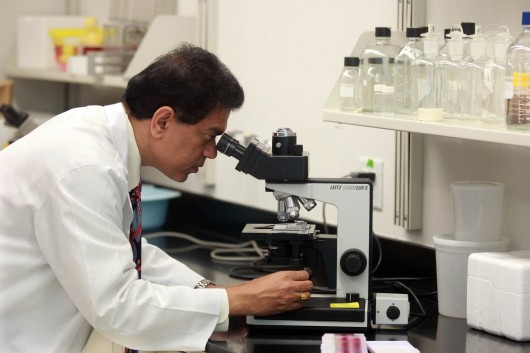
Dr. Dileep Yavagal works in the stem cell stroke basic science lab Aug. 14, 2014, at the University of Miami Miller School of Medicine in Miami.
Credit: Courtesy of TNS
The average age of scientists and engineers is rapidly increasing — and will continue to do so — according to a recent study by economists at Ohio State.
Economists David Blau and Bruce Weinberg found that between 1993 and 2010, the average age of employed scientists was 45.1 to 48.6. And that number is expected to grow, estimating an increase by another 2.3 years in the near future.
Weinberg said the motivation for this study was an interest in innovation and how it’s related to age, specifically considering at what point in people’s careers they are most innovative.
“The innovative workforce is getting older, and there’s the potential that as the workforce gets older for that to adversely affect the productivity and innovative output of the research community,” Weinberg said.
Some researchers have wondered whether the age of older scientists affects their work, given they might not be as creative or productive as they were at the beginning of their careers, and that older scientists might be keeping their younger peers out of the field, according to a news release for the study.
Using data from the National Science Foundation’s Survey of Doctorate Recipients and the U.S. Census, Blau and Weinberg used the information of 73,000 scientists aged 76 or younger, looking at age, field of degree, occupation, job tenure, employment history and sector of employment.
This increase in the age of the scientific workforce can be mostly attributed to the aging baby boomer population, but also the end of legally mandated retirement for university professors, which occurred in 1994 after a change in state law.
According to the study, 18 percent of scientists were aged 55 and older in 1993, but that number almost doubled to 33 percent in 2010. In comparison, the number of all workers 55 and older increased from 15 to 23 percent during the same time period.
Blau and Weinberg’s data show an increase in the age of scientists in almost all fields, even in fields like computer and information science, which has historically been made up of a much younger workforce. The study showed that the average age of computer scientists is actually increasing much quicker than other fields.
At public universities such as OSU, Blau said that while there’s been a large increase in the hiring of associate and clinical faculty members, whose main job is only to teach, there hasn’t been a big increase in the number of tenure-track faculty who are hired with a research focus.
“The connection between that and the aging of the scientific workforce is not necessarily one-to-one, but it does kind of raise the question of whether a scientific workforce is being replenished enough, at least at Ohio State,” Blau said.
Although their study might eventually point to more direct implications for the scientific research community, Weinberg and Blau say those possibilities have yet to be proven.
Weinberg said that while their research does not specifically show how many younger scientists were barred from getting jobs because of older scientists still working, he does see the graying workforce as a potential factor hindering young scientists as they attempt to launch their careers.
“This aging has made it harder for young researchers to establish their own independent careers,” Weinberg said. “We haven’t been able to say for Ohio State, or even for the workforce as a whole, what the implications are in any specific way, but we do have a general sense that there would be likely more opportunities if there hadn’t been as much aging.”
Despite these potential implications, Weinberg said he believes this study should not keep young scientists from pursuing careers.
“A research career is incredibly gratifying and I certainly wouldn’t want to discourage anyone from (taking on a research career),” Weinberg said. “I would certainly say that people should get information about what these careers look like and make informed decisions.”


